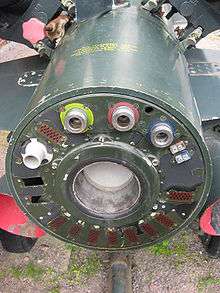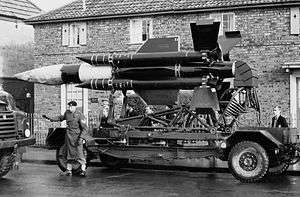Thunderbird (missile)
| Thunderbird | |
|---|---|
|
Thunderbird I parked at Filton, UK, following a tow vehicle breakdown (1960) | |
| Type | ground to air missile |
| Place of origin | UK |
| Service history | |
| Used by | British Army |
| Production history | |
| Manufacturer | English Electric |
| Specifications | |
| Length | 20 ft 10 in (6.35 m) |
| Diameter | 1 ft 8.7 in (0.527 m) |
| Warhead | Continuous-rod HE warhead |
|
| |
| Wingspan | 5 ft 4 in (1.63 m) |
| Speed | mach 2.7 |
Guidance system | semi-active radar homing |
Launch platform | Single rail, ground mounted (not mobile) |
The English Electric Thunderbird was a British surface-to-air missile produced for the British Army. Thunderbird was primarily intended to attack higher altitude targets at ranges up to approximately 30 miles, providing wide-area air defence for the Army in the field. AA guns were still used for lower altitude threats. Thunderbird entered service in 1959 and underwent a major mid-life upgrade to Thunderbird 2 in 1966, before being slowly phased out by 1977. Ex-Army Thunderbird I's were also operated by the Royal Saudi Air Force after 1967.
Thunderbird had performance similar to other semi-portable missiles like the US MIM-23 Hawk and fully mobile Soviet 2K11 Krug, although it pre-dates both of these systems and offered greater range over them, but have slower speed compared to the soviet 2K11 Krug. After its mid-life upgrades, which shared several components with the RAF's Bristol Bloodhound, Thunderbird featured a continuous-wave radar semi-active homing system that was highly resistant to Radar jamming and deception, and was able to track targets even at very low altitudes.
Thunderbird was the Army's only heavy anti-aircraft missile. As missile systems like Thunderbird made flight at medium and higher altitudes practically suicidal, nap-of-the-earth flying became the norm and even shorter-range, faster acting systems were needed. Thunderbird's role was taken over by the much smaller BAC Rapier as they became available.
History
The Stage Plan
The Thunderbird originated in a proposal to English Electric in 1949 to develop a missile to provide ground based air defence to the British Army in the field. As such, it was intended to replace the 3.7-inch heavy anti-aircraft gun that fulfilled this role during World War II. Like the 3.7, the new missile would be operated by the Royal Artillery. English Electric created a Guided Weapons Division to work on the project.
While the project was starting, the Ministry of Supply (MoS) began work on what would become known as the "Stage Plan", which envisioned a multi-stage program to provide an integrated air-defence network including new radars, interceptor aircraft, and missiles. As the missiles were the least understood technology, the MoS decided to implement their deployment in two stages. "Stage 1" called for missiles with a range of only 20 miles with capabilities against subsonic or low-supersonic attacking aircraft, which were assumed to be at medium or high altitudes. The Stage 1 missile would be used to protect the V bomber bases in the UK, as well as the British Army in the field.[1] The Stage 1 missile would be later replaced with a much higher-performance and longer-range "Stage 2" system in the 1960s, based on the "Green Sparkler" missile.[1] The Stage 2 missile was to have greatly increased range, speed and altitude capabilities.
Two entries were accepted for the original Stage 1 proposal, English Electric's existing project under the name "Red Shoes",[2] and Bristol's "Red Duster".[3] The two systems were very similar in design and performance, with the Bristol model differing primarily by offering somewhat longer range at the cost of being less mobile. Given the similarities, a single set of radars was developed that could be used with either design. This consisted of a Ferranti developed search radar and the target illuminating radar was the RRDE's "Yellow River" fire control radar built by British Thomson-Houston.[4]
Development


EE's design quickly developed into a fairly simple cylindrical fuselage with an ogive nose cone, four cropped-delta wings just behind the middle point of the fuselage, and four smaller control surfaces at the rear, in-line with the mid-mounted wings. The fuselage had a slight boat-tail narrowing at the extreme rear under the control surfaces. The sustainer was to be a liquid fuel rocket developed for the missile, and was launched by four large "Gosling" solid fuel rocket boosters lying between the control surfaces and wings. The boosters featured a single oversized fin of their own, and are particularly easy to spot due to a small flat surface at the end of every fin. This surface provided an outward drag component that help pull the booster away from the main body when released, helped by the booster's asymmetrical nose cone. Guidance was via semi-active radar homing, the Ferranti Type 83 "Yellow River" pulsed radar serving both as an acquisition and illumination system. The same radar was used with the competing Red Duster.
The test programme used development vehicles D1 to D4. D1 and D2 established some of the basic configuration issues, whilst D3 and D4 were used to test the aerodynamics of the design. The Army rejected the idea of using a liquid fuel rocket because of the difficulty in handling the highly reactive fuel in the field, so a solid rocket sustainer had to be chosen instead. Several different models of sustainer were tried, most of them known as the "Luton Test Vehicle", or LTV.
While testing of the Red Shoes was underway, the "competition" in the form of Red Duster was also entering testing. Red Duster demonstrated several serious problems, and the Army ended any interest in it. In the end the Red Duster problems were sorted out fairly quickly, and it entered service slightly before Red Shoes, as the Bristol Bloodhound, Mk. I.
The production Red Shoes missile was officially named Thunderbird. It entered service in 1959 and equipped 36 and 37 Heavy Air Defence Regiments, Royal Artillery. It was the first British designed and produced missile to go into service with the British Army.
Further development
While development of the Stage 1 missiles was still ongoing, work on the Stage 2 systems was proving to be too far in advance of the state of the art to realistically enter service while the Red Duster and Red Shoes were still useful. In the meantime, advances in radar technology were proceeding rapidly, so it was decided to produce interim designs using new continuous wave radars which would dramatically improve the performance of the existing missiles.
In the case of the Thunderbird, the "Stage 1½" design utilized the new Type 86 "Indigo Corkscrew" radar. As this was developed it changed names several times, becoming "Green Flax", and after some paperwork with that name on it was lost and assumed compromised, "Yellow Temple". In service it was known as Radar, AD, No 10 (fire control). The new radar greatly improved performance against low-level targets, as well as providing considerably better performance against electronic countermeasures.
To support Thunderbird operations in the field the regiments were equipped with the new Radar, AD, No 11 (tactical control, usually called 'big ears') and Radar, AD, No 12 (height finder, usually called 'noddy') radar, giving them a longer range surveillance system. These radars were also known to Marconi as the S303 and S404, or to the RAF as Type 88 and Type 89. After leaving Army service in 1977 they were turned over to the RAF who used them for tactical control.
Several changes to the basic missile were undertaken as well. Although the size remained the same, the new version featured much larger boosters, mid-mounted wings with sweep on the front and back, and a new nose cone with a much higher fineness ratio. The boosters lost their asymmetrical nose cones, but the surfaces on the end of their fins grew much larger. Overall the missile still looked much like the Mk. I version, as opposed to the Bloodhound which became much larger as it was upgraded.
The improved missile was known in service as Thunderbird 2. They entered service in 1966 and were removed in 1977.[5]
Former Operators
-
 United Kingdom
United Kingdom - British Army
-
 Finland
Finland - Finnish Army - planned purchase of either Thunderbird or Bloodhound was eventually cancelled, but only after deactivated training missiles had been delivered in the late 1960s. These were used in the training role until 1979.
-
 Saudi Arabia
Saudi Arabia - Royal Saudi Air Force - 37 second-hand Thunderbird I missiles purchased in 1967
- Negotiations were also held with Libya and Zambia.
Survivors
Thunderbird remains a popular museum item in the UK. One of the missiles is now displayed outside the Midland Air Museum, Warwickshire, England. Another example on a launcher is displayed in The Royal Artillery Museum, Woolwich, England. A Thunderbird Mk1 is also on display at the National Museum of Flight located at East Fortune-just outside Edinburgh, Scotland. (http://www.nms.ac.uk/our_museums/museum_of_flight.aspx ) A Thunderbird is also stationed outside the Combined Services Military Museum at Maldon in Essex. (http://www.cmsm.co.uk/)
Two of the Finnish missiles survive, one missile is located in Museo Militaria, Hämeenlinna, another in the Anti-aircraft Museum, Tuusula.
In the Doctor Who story "The Mind of Evil", The Master organises a band of prison convicts to steal a Thunderbird from the army before its disposal in the sea. The current existence of the actual missile loaned during the production are not known.
Specifications
- Length : 6.35 m
- Body Diameter : 0.527 m
- Fin Span : 1.63 m
- Warheads : Continuous HE rod
- Speed : Mach 2.7
- Range : 75 km
See also
- Bristol Bloodhound - a similar weapon adopted by the RAF
- Hawker Siddeley Sea Slug - a similar weapon adopted by the Royal Navy
- List of Rainbow Codes
References
- Notes
- 1 2 "The Stage Plan" skomer.u-net.com
- ↑ "Red Shoes" skomer.u-net.com
- ↑ "Bloodhound" skomer.u-net.com
- ↑ Cold War, Hot Science: Applied Research in Britain's Defence Laboratories, 1945-1990 Bud, Gummett NMSI Trading Ltd, (2002) p228
- ↑ Thunderbird Surface to Air Missile System
- Bibliography
- "Thunderbird" Flight 25 September 1959 pages 295-299 and 302-303
External links
![]() Media related to English Electric Thunderbird at Wikimedia Commons
Media related to English Electric Thunderbird at Wikimedia Commons
- "Emphasis on Mobility" a 1959 advertisement for the Thunderbird in Flight magazine
